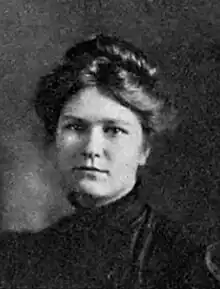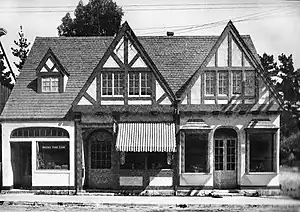Dene Denny
Dene Denny (February 11, 1885 – September 24, 1959) was an American musical theater producer who, along with co-founder Hazel Watrous, established the Denny-Watrous Management. They played pivotal roles in the inception of the Carmel Music Society, the Carmel Bach Festival, and Monterey's First Theater. Their residence, the Denny-Watrous Studio, served as a hub for hosting musical concerts and lectures.[1][2][3][4] Watrous and Denny held a strong belief that Carmel had the potential to become the "epicenter of world-class music."[5]
Dene Denny | |
|---|---|
 Denny at University of California Berkeley (1907) | |
| Born | Ethel Adele Denny February 11, 1885 |
| Died | September 24, 1959 (aged 74) |
| Occupation(s) | Pianist, teacher |
| Partner | Hazel Watrous |
Early life
Ethel Adele Denny was born on February 11, 1885, in Callahan, California. Her parents were Albert Hendrickson Denny (1835-1907) and Gertrude Althea Cadwell (1857-1949).[6][1] Denny's father was a banker, merchant, and the founder of one of California's earliest chain stores.[7] The family owned and operated a 1,000 acres (400 ha) ranch in Northern California.[8]
After finishing her high school education at Oakland, California, Denny proceeded to the University of California, Berkeley, where she graduated with honors in English. She earned both a BA and MA degree from the university. She went to New York to undergo formal piano studies. Denny then established a music studio in San Francisco, where she taught piano to her students.[7][1][9]
Career
Carmel-by-the-Sea
In 1922, Denny and Watrous first encountered each other at a party held in the studio of a mutual friend in San Francisco and quickly became a couple.[8] They embarked on a journey to New York City, opting for a detour through Carmel-by-the-Sea in 1923. Once they reached Carmel, they discovered a city entirely devoted to the arts, which left a lasting impression on them.[7][9]
To generate income, Denny and Watrous took on the task of designing residential houses, completing a total of 36 homes. Among these projects were Johan Hagemeyer home and studio (1923) and plant biologist Fremont Ballou's board-and-batten cottage located on Carmel's Upper Trail.[8][4] Their designs were innovative, drawing inspiration from the Arts and Crafts movement, with exposed beams and wooden interiors, along with board and batten exteriors.[7][2][10]
Denny-Watrous Studio (Harmony House)
Denny and Watrous had purchased a lot from Frank Davendorf in 1922, and temporarily resided above a garage while Watrous designed and built a two-story American Craftsman-style home, now called "Denny-Watrous Studio" or commonly known as "Harmony House." They expanded it into a studio in 1926.[11][2][12][7] The Denny-Watrous house became a gathering place for musical performances and lectures exploring new sounds and ideas. In 1925, composer Henry Cowell showcased his tone clusters, and architect Richard Neutra gave a lecture on modern building design. Recitals led to the establishment of the Carmel Music Society.[7]
The Denny-Watrous Studio was registered with the California Register of Historical Resources on April 8, 2002. It holds significance as a representation of Watrous's architectural expertise, as she was responsible for designing and constructing up to 36 residential properties during the 1920s.[10]
In 2017, a fire nearly destroyed Harmony House. However, the owners rebuilt the house in the same style.[13]
Denny-Watrous gallery

In 1929, Denny and Watrous established the town's first fine arts gallery, the Denny-Watrous gallery, in the De Yoe Building. In 1931, they added a stage for theatrical performances and sponsored chamber-music recitals.[14] In the gallery, Denny and Watrous presented paintings by Galka Scheyer's Blue Four, and the first rehearsals of the amateur orchestra took place. The first known American performance of Bach's composition The Art of Fugue was performed there.[7][1][8]
On January 8, 1933, they signed a receipt at the De Young Museum for 64 prints comprising the exhibition of the Group f/64, a group founded by seven San Francisco Bay Area photographers. The Carmel Pine Cone reported that 9 photographers appeared in the exhibition including photographer Edward Weston.[8][15]
In 1935, the Denny-Watrous gallery later moved to the Murphy Building on San Carlos Street.[9] In April 1935, opera singer Maria Montana performed at the Denny-Watrous Gallery.[3]
Carmel Music Society
In 1927, Denny and Watrous assembled a group of music enthusiasts from the local community, leading to the inception of the Carmel Music Society. They collaborated with Henry F. Dickinson and his wife Edith, who became the organization's inaugural treasurer and one of its first presidents respectively.[16][17]
In 1932, Denny and Watrous brought the Neah-Kah-Nie String Quartet, with Michel Penha as its director and cellist to Carmel. The ensemble eventually evolved into the Monterey County Symphony, made possible through the sponsorship of the Carmel Music Society.[18][7]
Denny-Watrous Management

In 1928, the official partnership of Denny-Watrous Management was launched. They secured a lease for the Theatre of the Golden Bough from Edward Kuster, and in 1937 leased California's First Theater in Monterey, a State Historical Landmark, from the Monterey History and Art Association. On June 3, 1937 the theater reopened as a playhouse where the Troupers of the Gold Coast performed.[19][8] Under Denny's management, the theater staged more than 100 plays, putting a total of approximately 1,500 performances.[9] Over twelve months, they produced a total of twelve concerts and eighteen plays, among them Ferenc Molnár's Liliom, Eugene O'Neill's The Emperor Jones, and Henrik Ibsen's Ghosts.[7]
In 1934, composer Ernst Bacon was appointed as the conductor of the Monterey County Symphony, marking the commencement of planning for the Carmel Bach Festival. Denny and Watrous established the Carmel Bach Festival, which debuted its inaugural season in 1935, with Bacon as conductor.[7] In spring 1958, the Bach Festival was officially incorporated with a board of directors, with Denny serving as the president and general manager.[9]
Death
On September 24, 1959, in Carmel, California, Denny died at her home on Dolores Street. Her funeral service was held at the Little Chapel by the Sea in Pacific Grove, California.[1][9]
Notable work
References
- "Miss Dene Denny Dies At Home in Carmel". The Californian. Salinas, California. September 24, 1959. p. 2. Retrieved July 17, 2023.
- "Homes of Famous Carmelites" (PDF). ci.carmel.ca.us. Carmel-by-the-Sea, California. 1992. Retrieved April 11, 2023.
- Gordon, David J. (2014). Carmel Impresarios A Cultural Biography of Dene Denny and Hazel Watrous. Lucky Valley Press. ISBN 978-0-9856655-4-8. Retrieved April 12, 2023.
- Seavey, Kent (2007). Carmel, A History in Architecture. Carmel-by-the-Sea, California: Arcadia Publishing. p. 123. ISBN 9780738547053. Retrieved April 5, 2023.
- Watson, Lisa Crawford (July 6, 2015). Legendary Locals of Carmel-by-the-Sea. Carmel-by-the-Sea, California: Arcadia Publishing Incorporated. p. 81. ISBN 9781439651179. Retrieved May 1, 2023.
- "Historical Information for Ethel Adele Denny". FamilySearch. Retrieved July 17, 2023.
- Wright, Connie (2014). "Dene Denny & Hazel Watrous Carmel Impresarios". Stories of old Carmel: A Centennial Tribute From The Carmel Residents Association. pp. 38–39. OCLC 940565140.
{{cite book}}:|work=ignored (help)CS1 maint: location missing publisher (link) - Alinder, Mary Street (2014). Group F.64. pp. 34–35. ISBN 9781620405550.
{{cite book}}:|work=ignored (help) - "Dene Denny Dies". Carmel Pine Cone. Carmel-by-the-Sea. September 24, 1959. pp. 1, 17. Retrieved July 17, 2023.
- Richard N. Janick (July 31, 2002). "Department Of Parks And Recreation" (PDF). National Park Service. Retrieved July 17, 2023.
- Dramov, Alissandra; Momboisse, Lynn A. (2016). Historic Homes And Inns Of Carmel-by-the-Sea. Carmel-by-the-Sea, California: Arcadia Publishing. p. 26. ISBN 9781467103039. Retrieved April 2, 2023.
- "Carmel Inventory Of Historic Resources Database" (PDF). City Of Carmel-by-the-Sea. Carmel-by-the-Sea, California. Retrieved February 15, 2023.
- "'Harmony House' destroyed by fire" (PDF). Carmel Pine Cone. Carmel-by-the-Sea. June 9, 2017. pp. 1, 13. Retrieved July 18, 2023.
- Richard N. Janick (July 8, 2002). "Department Of Parks And Recreation" (PDF). National Park Service. Retrieved April 8, 2022.
- "Photo Exhibit". Carmel Pine Cone. Carmel-by-the-Sea. January 27, 1933. p. 18. Retrieved July 17, 2023.
- "Carmel Music Society". www.carmelmusic.org. Retrieved April 12, 2023.
- Hudson, Monica (2006). Carmel-by-the-sea. p. 64. ISBN 9780738531229. Retrieved March 16, 2022.
{{cite book}}:|work=ignored (help)CS1 maint: location missing publisher (link) - "1957 Carmel Bach Festival Program". Harrison Memorial Library. Carmel-by-the-Sea, California. 1957. Retrieved July 17, 2023.
- "California's First Theater" (PDF). Monterey History. Monterey, California. May 31, 1961. Retrieved July 18, 2023.